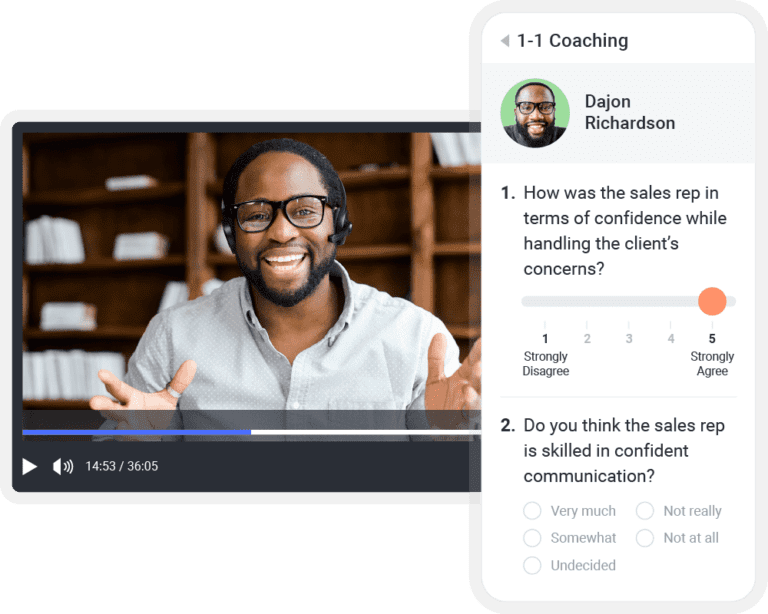The reality is, deal coaching is probably happening pretty regularly at your organization. Managers are meeting with their teams as a whole, and individually to discuss open opportunities in flight, how they are progressing, and how they can help get them to closed-won.
But, the same can’t typically be said for skill coaching across the board. That’s because skill coaching traditionally takes more prep, data, and tracking to be effective. Since it is more of a time commitment for managers, it gets pushed to the back burner, with other pressing tasks taking precedence over it.
With a bit of guidance, you can ensure skill coaching is consistent across your organization and impacting rep performance quarter after quarter.
What is skill coaching?
First, let’s start with a quick overview of what skill coaching is. And how it’s different from deal coaching.
Focuses on the deals in front of a seller, and the open opportunities they have and are actively working. This type of coaching typically takes place between a manager and a rep weekly, discussing the details of each deal, any blockers, the next steps, and the probability of closing.
Focuses on the seller themselves, and more specifically the key skills they need to be successful at their job. Skill coaching sessions typically happen on a monthly or quarterly basis, as it takes time to show improvement.
Deal coaching and skill coaching are both strategic techniques for guiding sellers on how they can be more effective. Paired together, they can result in an improvement of win rates by 27% or more.
Why do skill coaching metrics matter?
Now that you know the why of skill coaching – what is the point of measuring and tracking performance related to skill coaching?
Metrics matter because they are the driving force behind delivering effective skill coaching.
If you have a team of reps and want to start focusing on delivering skill coaching, without any data, you may just result to picking one skill to coach your team on each month.
For example, you choose discovery and focus on assessing and building this skill for each rep. If one member is already very strong in his or her discovery skills, this could be a waste of time for this person. While another member may have a larger gap in discovery skills and needs more than a month for developing this skill.
Without metrics, you can’t deliver tailored skill coaching that focuses on the individual skill gaps of each of your team members.

20+ coaching metrics for effective skill coaching
In order to start tracking skill coaching metrics, you must first know exactly what skills make up a top performer in your organization. And this varies by role, industry, and product/service offering.
For example, a Sales Development Representative at a tech company may need strong skills in:
- Active listening
- Market research
- Written communication
- Self-motivation
While a seasoned Account Executive at a manufacturing company needs really strong:
- Discovery
- Problem-solving
- Negotiation
- Presentation
Now using these competency frameworks, you can start to measure the critical metrics that will drive your skill coaching efforts for each of your customer-facing roles.
Let’s break down the metrics by commonly used skills for go-to-market roles.
| Product/service knowledge | Product/service program scores |
| New product/service release update scores | |
| Correct answers on assessments and quizzes | |
| Certification completions | |
| Active listening | Conversation intelligence call scores |
| Talk time % on calls vs attendees | |
| Conversion rate of calls to meetings booked | |
| Written communication | # of emails sent |
| Sentiment score on emails | |
| # of responses to emails vs emails sent | |
| Building rapport | Conversion rate of calls to meetings booked |
| Conversion rate of emails to meetings booked | |
| Presentation | Video role-play scores |
| Conversion by deal stage | |
| Talk time % on calls vs attendees | |
| Filler words used | |
| Sentiment on calls | |
| Questions asked by prospect in calls | |
| Questions asked by presenter | |
| Monologue length | |
| Multi-threading | # of contacts engaged per opportunity |
| # of contacts accepted/attending meetings | |
| # of c-level contacts engaged per opportunity | |
| Objection handling | Sentiment on calls |
| Questions asked by prospect in calls | |
| Questions asked by presenter | |
| Competitor mentions |
Measuring the impact of your skill coaching
Seeing all of these metrics in one list can be a bit overwhelming. We recommend starting small. Focus on 2-3 top skills for your direct reports and start tracking a handful of metrics for each of these skills to gauge where individuals are excelling or where they may need some focused skill coaching. Then, you can continue tracking these metrics over time to determine the effectiveness of your coaching and add additional metrics to track. All of these skills should be measured against larger KPIs and business goals of your reports, like:
- Revenue generation
- Quota attainment
- Pipeline conversion
- Average deal size
- Conversion by deal stage
There are many solutions out there that can help track these metrics, which may result in jumping back and forth between systems to gather all of this data. If you’re interested in a coaching solution that consolidates your sales enablement and ops data for actionable coaching insights, reach out to a Mindtickle expert.
Start Measuring the Impact of Sales Coaching
Make sure skill coaching is consistent and impacts rep performance quarter after quarter.
Get a Demo
This post was originally published in November 2022 and was updated in September 2023.







